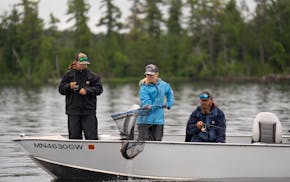The signs posted on the Xcel Energy mountain bike trail system at Quarry Lake Park in Shakopee make it clear:
No throttles allowed.
"I can think of multiple instances of confrontations with groups riding those bikes," said Kyle Sobota, senior city planner and coach of the Shakopee mountain biking team, which helps maintain the trail.
"Those bikes" are a specific type that are often called electric motorbikes or "e-motos." Some models can reach more than 40 mph, and they're an increasingly common sight where they shouldn't be, such as on multiuse paths, mountain bike trails and city streets.
"They're everywhere," said Jason Tufty, president of Minnesota Off-Road Cyclists (MORC), a volunteer group that builds and maintains mountain biking trails.
Though some e-moto bikes are legal, others are technically not because they have a throttle and motors that can propel them more than 28 miles per hour — a speed beyond what Minnesota law allows for e-bikes.
Tufty and Sobota said e-motos have drawn attention because the bikes have become popular among younger riders, some of whom struggle to handle the bikes or who might be younger than Minnesota's legal age of 15 to ride an e-bike.
E-motos have become such a safety issue that even the motocross crowd doesn't want them in areas near their races.
One of the state's top motorsports groups decided to ban any e-bike with a throttle from the pits at its sanctioned events this season. E-moto riders overmatched by their bikes have been in solo wrecks or endangered others, said one of the group's leaders.
"It has hit our world," said Rex Greenwald, board chair of the District 23 Amateur Riders Motorcycle Association, which puts on dozens of races, such as motocross and flat track.
"It's a group with nowhere to go," said John Sheehan, who owns Roam bike shop in White Bear Lake.
Sheehan worries that e-motos — and the concerns they are raising among other cyclists and trail-users — are putting all e-bike riders in a negative light. "Everyone is lumping all e-bikes together," he said.
Wanting to avoid trouble
E-moto bikes come in different forms. Some look like old-school dirt bikes, with pegs instead of pedals, special tires and suspension. But only motorized dirt bikes with proper licensing, insurance, lights and signaling are allowed on Minnesota roads — adhering to the rules that classify them as a motorcycle, according to a spokesperson with the state's Department of Public Safety.
Others look similar to mopeds. And still others look like regular e-bikes.
In Minnesota, a legal bike motor can't exceed 750 watts.
Tufty and his MORC colleagues said they think the e-moto bikes' potential speeds and weight — some are 70 pounds and heavier — are what make them dangerous when they mix with regular bikes, and are why the group is considering clarifying MORC trail rules.
MORC volunteers maintain 19 mountain biking trail systems, including several in the Three Rivers Parks District reserves such as Elm Creek in Maple Grove and Lake Rebecca near Rockford.
"[E-motos] are not necessarily damaging the trail surface, but they are heavier and faster and their presence on trails can be intimidating for other users," Tufty added. "It's more about how they move and interact. If there happened to be a collision, it would be ugly."
The Braemar mountain biking trail system in Edina seems to be more popular with e-moto riders than other systems, he said, but "every trail that we have will have an e-moto bike on it every day." Like the Xcel Energy trail in Shakopee, Braemar forbids bikes with throttles.
Tufty said MORC doesn't have the ability to enforce its rules, but would like to see the state find a way to keep e-motos out of areas meant for legal e-bikes.
"I don't want to go crazy bashing them. They are kids having a good time. I just think there needs to be a solution," he said.
The Bicycle Alliance of Minnesota office in Minneapolis has heard about the noticeable increase in e-moto use at Braemar, communications manager Erik Noonan said. It complicates what is considered an e-bike positive: increased riding overall.
More people are out using public trails as the weather warms, producing a natural friction about the riding environment, Noonan said, "but there remain a lot of things not within the classifications that are out there."
Noonan said Bike MN has talked with Minnesota retailers who have sold e-bikes that are technically illegal, "and had careful conversations to correct those missteps."
Surron and Luna are among the popular online brands, selling some models that meet Minnesota standards and others that do not. Neither company responded to questions from the Minnesota Star Tribune.
Inconsistent information on e-bikes' motor power "also makes it more difficult for consumers to confidently purchase legal options," Noonan added.
"For the time being, our focus remains on increasing public awareness of [what is legal] and the reasons why it is important."
'We can't be everywhere'
The Gateway State Trail, which runs from St. Paul to Pine Point Park in Washington County, is one of the busiest multiuse paths in the metro, according to the Department of Natural Resources.
Nonwinter daily traffic on the east metro path has averaged hundreds of people, including cyclists, walkers, runners and even roller-skiers. The addition in recent years of the Brown's Creek Trail junction spilling into downtown Stillwater has made the trail even busier.
DNR conservation officers and local authorities are responsible for enforcing trail guidelines, which allow legal e-bikes. Electric-powered transport like scooters, skateboards and hoverboards is prohibited.
Wade Miller, who manages the DNR's state trails, said the agency has heard from trail users about e-moto riders, among other criticism, but hasn't seen evidence that suggests there are more mishaps involving e-bikes.
"People complain about the speed and size of e-bikes," Miller added, "but the data doesn't suggest there is a problem.
"We will continue to observe, manage expectations, and adapt as needed to ensure trail safety is a top priority for our visitors."
Three Rivers Parks District managers field calls, too, on its 180-mile trail system, which averages 5.5 million visits annually.
"We have park police, but we can't be everywhere," added Danny McCullough, regional trail system manager. The district has tried targeted enforcement, and reminds users to act responsibly in a shared space.
Back in Shakopee, the Xcel Energy trail signs prohibiting e-moto bikes advises contacting the police. It has had limited success.
"If [e-moto riders] get a warning, some are back out the next week," said Sobota, the city planner and mountain biking team coach.
A police spokesperson said the department reacts to complaints, but unless e-moto riders are seen on the trail, the rules are difficult to enforce.
Capt. Jamie Pearson said the department has tried to educate children through school resource officers because "it's kids on these things."
Sobota acknowledged the enforcement challenge. "It is very hard. The reality is a police officer is not going to be stationed out there."

Xcel lets loose a small army of hungry sheep to keep its solar farm in order

Anderson: In early June, Minnesota fish are begging to be caught. Won't you help?

So you want to get an e-bike? Here's what you should know in Minnesota
Baby opossums are emerging from their mothers' pouches

